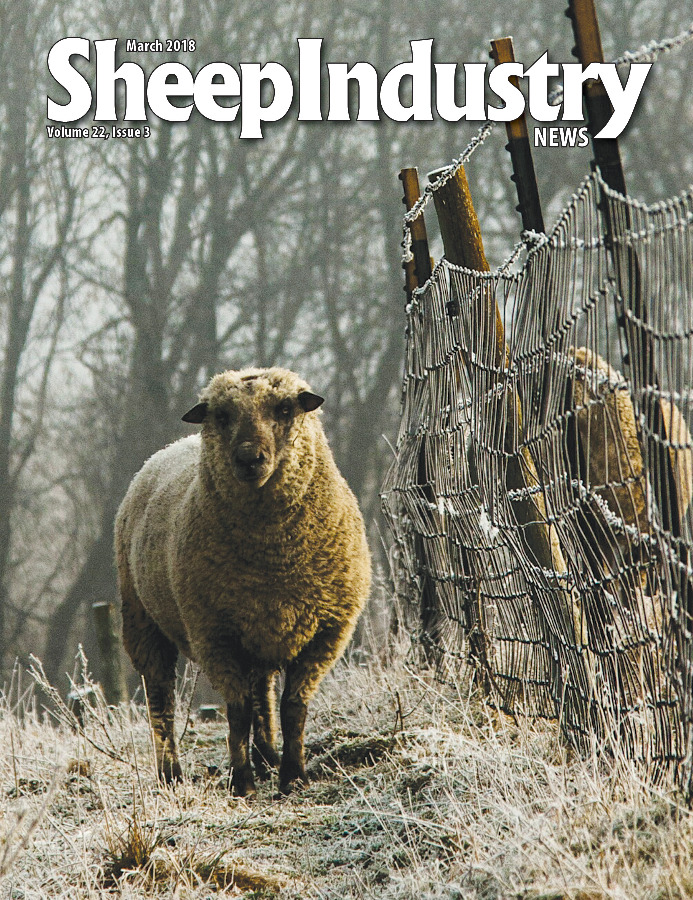
- March 2018
- President’s Notes
- Jerry King Cartoon
- Convention: Sheep Producers Share Concerns with USDA
- Convention: Industry Leaders Recognized
- Convention: MIWW Celebrates 70 Years
- Convention: American Wool Uses Technology
- Convention: Nourish With Lamb Spreads Message
- Convention: PERC Discusses Possible FMD Outbreak
- Convention: Kangols Top Guard Dog Breed
- Convention: Genetic Stakeholders Understand Value of Data
- Convention: Sheep Disease Updates
- Convention: Resource Management Eyes Progress
- Convention: Young Entrepreneurs
- Electronic Grading Approved at Superior Farms
- ALB Picks Denver as Next Target Market
- Wool is Popular at Outdoor Show
- Sheep Inventory Flat in 2017
- Feedlot Report Available
- Young Entrepreneur: Jake Kerr
- Sec. Perdue Names ALB Appointees
- Three Appointed to Sheep Center
- Around the States
- Market Report
- The Last Word
Genetic Stakeholders Committee Understands Value of Data
CAT URBIGKIT
The Shepherd
Sheep producers attending the recent Genetic Stakeholders Committee session were reminded that they live in a data-driven world and the need for it in the sheep industry is no less than elsewhere.
The push for objective measurements and genomic data isn’t just to create data, but the goal is to collect information that will be utilized by producers to make improvements, according to committee vice-chair Ron Lewis.
The committee has made good progress on most of its major goals in the last year:
• Encourage international sales (topic for next year);
• Seek breed registry association input (a meeting was held, will be a continued focus);
• Encourage uptake of objective measurements (current focus, and a centerpiece of Let’s Grow grant testing the use of terminal sire rams within commercial system);
• Encouraging uptake on genomics (to understand relationships between genes and traits).
Fine Wool
Producers Ben Lehfeldt, Matt Benz and John Helle gave an update on projects involving the Fine Wool Consortium, which seeks to strengthen the National Sheep Improvement Program database by increasing NSIP membership and data submission for fine wool breeds. Combining growth data and wool data should lead to more rapid genetic advancement for wool breeders, and the consortium hopes to develop a wool sub-index.
Benz said that in his view, there have been three major events in the history of the wool sheep industry in the United States: First, the early importation of Rambouillet; Second, British terminal sires; Third, Finnsheep importation.
“The next big thing that we think is really going to have an impact is the use of performance records,” Benz said, noting the impact of such records especially in the beef industry and other meat species.
Benz noted that in 2013, there were 10 fine wool breeders using NSIP – now there are 28, with most of that growth occurring in the last few years, bringing the number of total wool records up from 9,400 to about 19,000.
In addition to working to create the wool index, the consortium is working on an NSIP Data Genetic Link project on the Helle ranch in Montana, involving data collection on more than 200 yearling ewes split into 12 breeding groups. The project seeks to increase the genetic connectedness of its members, while allowing a high degree of confidence when comparing NSIP data of the flocks in the group. The consortium hopes to identify superior rams and ewes for its customers, while continuing to strengthen the genetic links among fine wool sheep.
Benz said there has already been improvement experienced in Rambouillet in the last five years, with yearling weights decreased about 5 pounds; greased fleece weights up .8 pounds; decreased fiber diameters while increasing staple length; and an increase in the number of lambs born.
“It indicates the trends are going in the right direction,” he said.
Helle noted that there will be a massive increase in the data available for fine wool producers in the next few years, especially when 25 years worth of flock records of the USDA Dubois Sheep Experiment Station are incorporated.
Genomics
Larry Kuehn of the U.S. Meat Animal Research Center talked about the incorporation of genomic information into genetic evaluation, using the American beef industry as a model.
Since domestication of sheep, the selection focus has been based on visual appraisal, which has resulted in the dozens of sheep breeds in existence today.
But within the last 100 years, tools were developed to measure phenotypes – as in NSIP providing Estimated Breeding Values – that measure these trait complexes (weights, fleece, composition, reproduction, parasite resistance).
“The profits come from data recording, Kuehn said. “We need data.” Kuehn said sheep breeders should consider adding genomics to the EBV process.
The goals of using genomic information include providing an early prediction of genetic merit, decrease generation interval, providing of traits that are not part of the genetic evaluation process (which has led beef producers to use a relationship matrix), and to increase the transfer of predictions across lines and breeds.
“High accuracy EBVs require progeny testing, and that takes time,” Kuehn said. “We need daughters that are producing daughters.”
In order to move forward with genomics, the industry needs to create infrastructure, including housing a database that will facilitate sharing for genetic evaluation – which means that producers have to decide to share data.
This is not a competition, Kuehn emphasized.
“This is a collaborate effort and it needs to be collaborative to be done well. The potential benefit is high,” he added.

